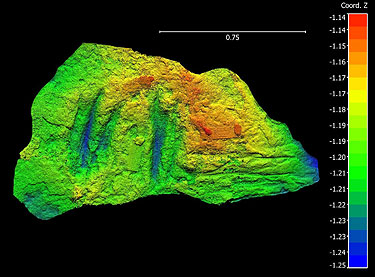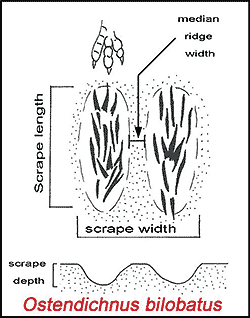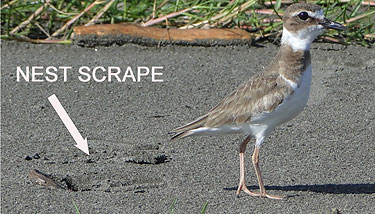 |
| 3D image of nest scrape courtship feature made by a theropod dinosaur in 100-million year old Cretaceous Dakota Sandstone near Delta, Colorado. Note clear 3-toed trace on left side. |
Last month’s Moab Happenings introduced one of the world’s richest track-bearing deposits, the Dakota Sandstone. During the Cretaceous this 100-million-year-old tracker’s paradise consisted of miles and miles of wetlands, lakes, floodplains, and river courses making up a lush swampy coastal plain ideal for registering footprints. The area teamed with dinosaurs, turtles, crocodiles, pterosaurs and invertebrates such as horseshoe crabs. These creatures left more than 125 tracksites from Kansas to Utah, comprising what has been called an ancient Dinosaur Freeway which extended for hundreds of miles, making up a precursor to today’s Gulf of Mexico coastal plain where it is impossible to go far without finding abundant footprints.
Such abundance tracksites provide evidence of ancient ecology. Herbivorous dinosaurs crossed the trails of carnivorous theropods and crocodiles, while pterosaurs and turtles paddled in the shallows leaving swim tracks. One Dakota Sandstone tracking detail deliberately left out for special treatment this month involves special evidence that few trackers would ever have anticipated finding: i.e., direct evidence of dinosaurian courtship behavior.
Paleontologists have speculated on what dinosaur courtship behavior “might” have looked like. Notice the emphasis on “might.” As birds represent today’s living theropod dinosaurs we “might” say their courtship behavior resembled that of theropods. They “might” for example have used their colored feathers and crests, in energetic display dances to attract mates. They likely assembled in the mating season (spring in most areas) in what are called leks: sites where today’s birds assemble to show off their prowess as potential mates. Such displays attract today’s ornithologists who enthusiastically observe the courtship season behavior of sage grouse or sandhill cranes. But as ornithologists do not look for scrapes, they miss the physical evidence that “might” remain in the geological record. Lekking seems to have been an essential, instinctive behavior evolved into bird and theropod dinosaur behavior for millions of years.
 |
| The courtship display traces made by theropods named Ostendichnus bilobatus, denote the ostentatious nature of “show off” behavior preserved by paired (bilobed) grooves made by left and right feet. Such traces are found in the Dakota Sandstone of the Dinosaur Diamond area in western Colorado. |
 |
The courtship display traces made by theropods named Ostendichnus bilobatus, denote the
A small nest scrape display trace made by a small shorebird during the breeding season. Such living birds are descendants of Cretaceous theropod dinosaurs. This suggests such courtship behavior has persisted for 100 million years. |
While birds that nest in trees or cliffs may “show off” to potential partners by building multiple nests for inspection, ground nesting birds have the habit of making what ornithologists call ‘pseudo nests’ or ‘nest scrapes’ in lek areas described as ‘display arenas.’ (Were these the Cretaceous equivalent of today’s discos)!? Today small plovers and sandpipers energetically make nest scrapes along shorelines. Instinctive lekking energy is such that individual birds might make dozens, even hundreds of scrapes in short order. Potential partners may be ‘picky’ and reject unsuitable scrapes, or they may challenge prospective mating partners to prove their stamina. Who knows the mind of the bird or dinosaur at the height of the sexual display season?
While fossil dinosaur and bird nest colonies are known, those of Mesozoic dinosaurs mostly represent herbivorous dinosaurs, and those of post Mesozoic birds mostly represent flamingo like species from lake basins. Such nests are not named as separate trace fossils, even when they contain eggs (which are often classified. However, the nest scrapes have been named as Ostendichnus bilobatus (meaning ostentatious, “show off,” bilobed traces marked by two parallel scrapes made by the hind feet). These “showing off” traces are abundant in the track-rich Dakota Sandstone in the Dinosaur Diamond area around Delta, Colorado. These scrapes are the only direct physical evidence of dinosaur courtship behavior. As dinosaurs would not have nested far from their courtship display arenas nesting must have taken place nearby even though the nests have yet to be found. Again, the Dakota Sandstone is featured as a footprint-rich tracker’s paradise.
|